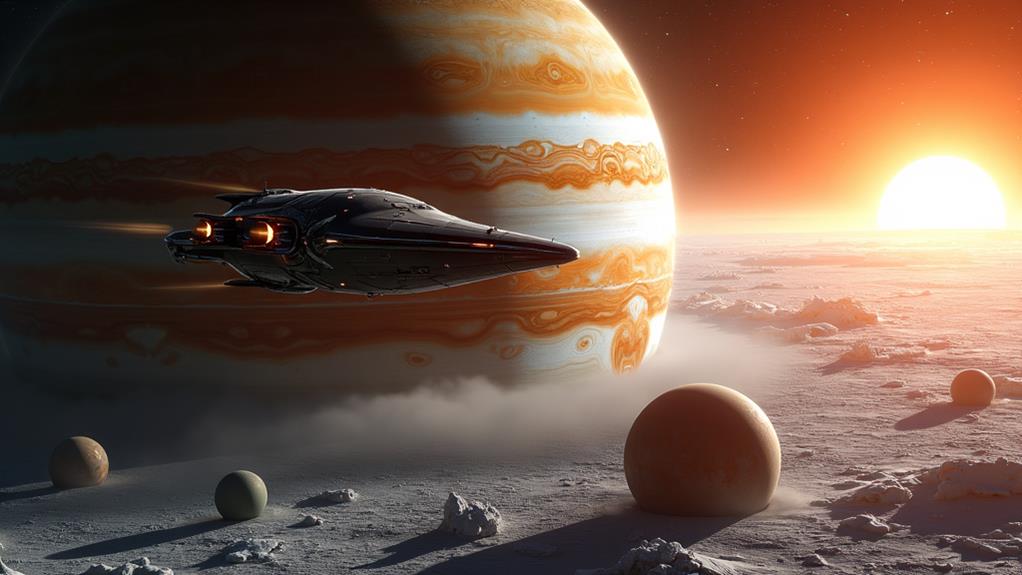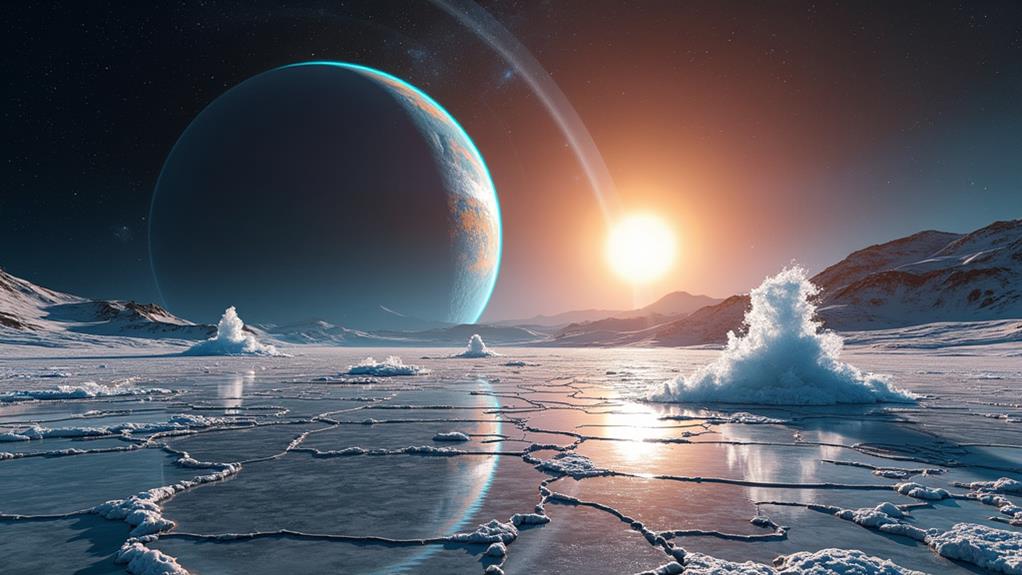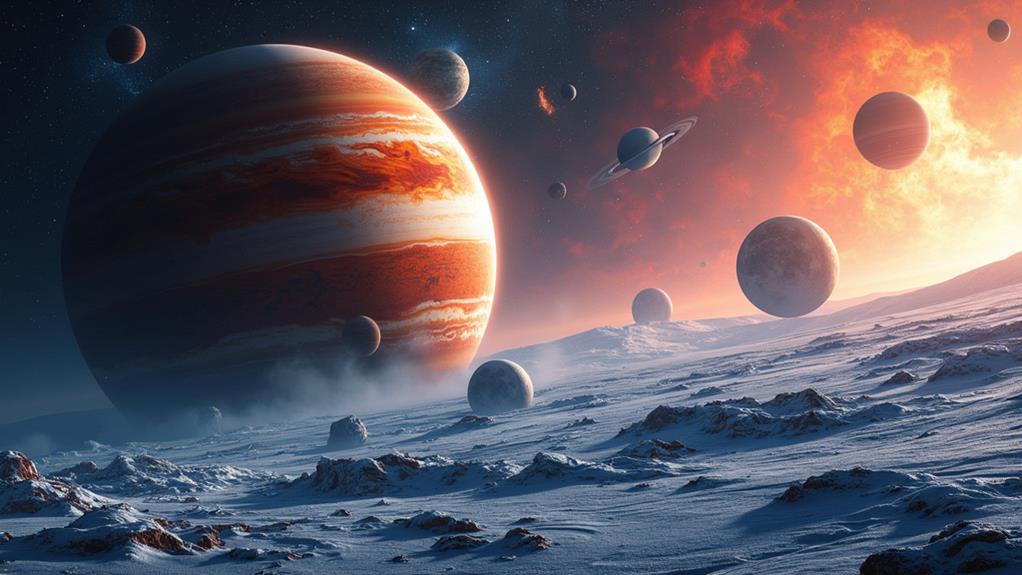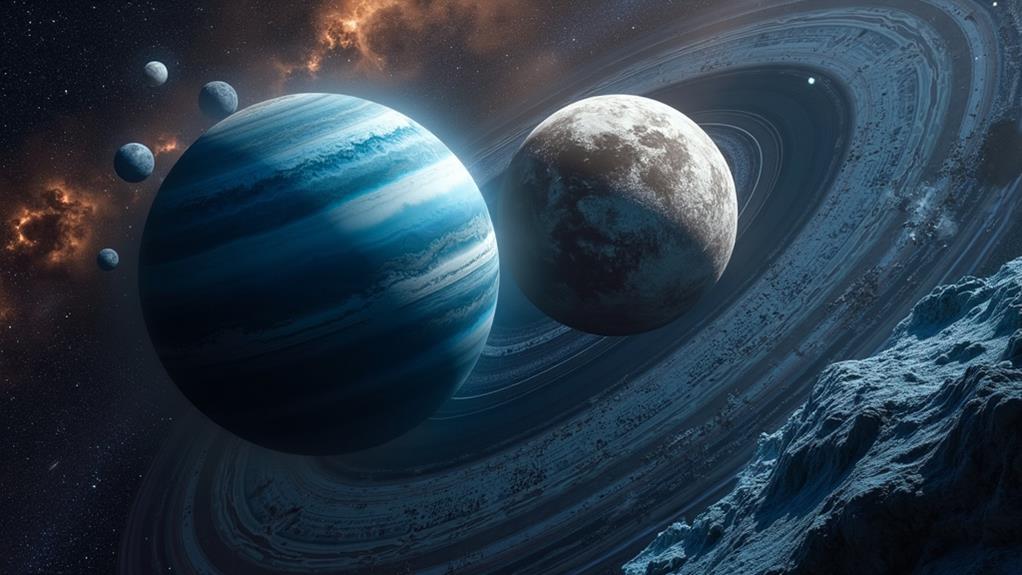Exploring Jupiter and Saturn's Largest Moons
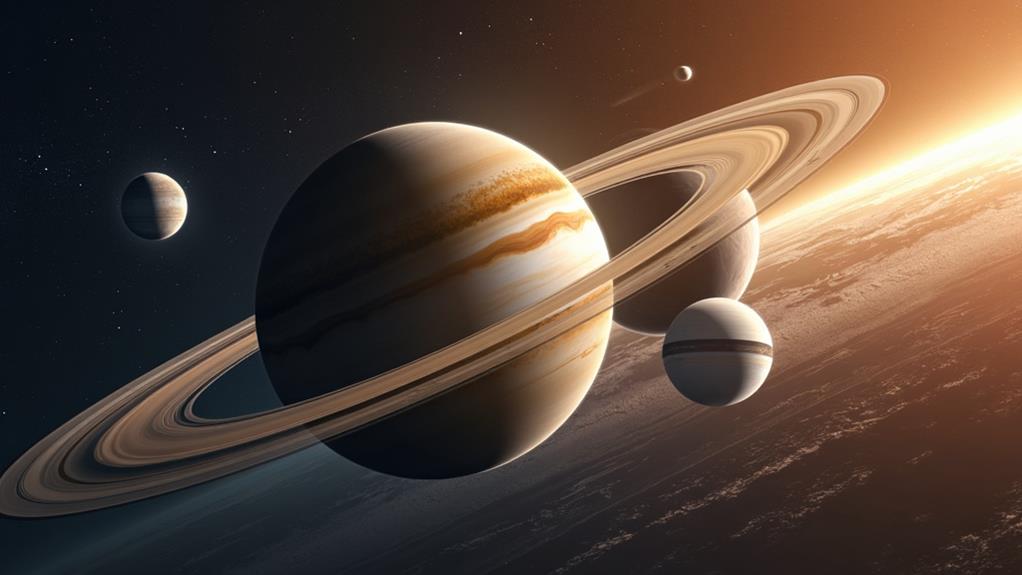
Investigate the largest moons of Jupiter and Saturn, starting with Jupiter's Galilean moons: volcanic Io, ocean-hiding Europa, massive Ganymede with its magnetic field, and ancient Callisto. Then, shift to Saturn's intriguing Titan, covered in hydrocarbon lakes and rivers, and icy Enceladus, which hints at a subsurface ocean. Don't forget Hyperion's unique sponge-like appearance. Each moon offers unique geological and atmospheric phenomena, sparking missions like NASA's Europa Clipper and the planned Dragonfly to Titan. There's much more to uncover about these fascinating celestial bodies.
Key Takeaways
- Galilean moons of Jupiter exhibit diverse geological features, including Ganymede's magnetic field and Io's extreme volcanic activity.
- Europa's subsurface ocean and water vapor plumes make it a prime candidate for studying potential extraterrestrial life.
- Titan, Saturn's largest moon, has a dense atmosphere and liquid hydrocarbon lakes, with upcoming missions like Dragonfly set to explore its surface.
- Enceladus, with its geysers and possible subsurface ocean, offers significant astrobiological interest and potential for discovering organic compounds.
- Future missions like NASA's Europa Clipper and ESA's JUICE aim to investigate the habitability and geological history of these moons.
The Galilean Moons
The Galilean moons of Jupiter—Io, Europa, Ganymede, and Callisto—are a fascinating quartet, each with unique characteristics. Unveiled by Galileo Galilei in 1610, these moons are the four largest orbiting Jupiter and stand among the most intriguing objects in the solar system.
Io, the most geologically active body in the solar system, boasts over 400 active volcanoes. With a diameter of 2,260 miles (3,640 km), its dynamic surface is constantly reshaped by volcanic activity. You'll find it mesmerizing to investigate Io's lively landscape.
Europa, slightly smaller with a diameter of 1,940 miles (3,100 km), holds a secret beneath its icy crust. Scientists believe it's hiding a subsurface ocean, making Europa a key target in the search for extraterrestrial life. Imagine the possibilities lurking beneath its frozen exterior.
Ganymede, the largest moon in the solar system at 3,270 miles (5,260 km) in diameter, is unique due to its magnetic field. It's a colossal moon that stands out in Jupiter's celestial lineup.
Callisto, with a diameter of 2,995 miles (4,820 km), features the oldest landscape among the Galilean moons, marked by a heavily cratered surface. Its ancient terrain tells a story spanning billions of years.
Ganymede: The Giant Moon
Among the Galilean moons orbiting Jupiter, Ganymede stands out not just for its massive size but for its unique features that set it apart from its celestial siblings. As the largest moon in the solar system, Ganymede boasts a diameter of 3,270 miles (5,260 km), surpassing even Mercury. What truly makes Ganymede exceptional is its magnetic field, the only one known among moons, likely generated by a liquid iron-sulfide core.
Ganymede's surface reveals a fascinating mix of bright, icy regions adorned with ridges and grooves, and darker areas peppered with impact craters. This diverse terrain hints at a dynamic geological history. Beneath its icy surface, there's compelling evidence suggesting the existence of a subsurface ocean. This hidden ocean raises intriguing possibilities about the potential for extraterrestrial life.
The moon's auroras, detected during Juno spacecraft flybys, are another engrossing aspect. These shimmering lights are a result of Ganymede's magnetic field interacting with Jupiter's powerful magnetosphere. In the vast expanse of the solar system, Ganymede stands as a giant moon with mysteries that continue to enthrall scientists and space enthusiasts alike.
Europa's Subsurface Ocean
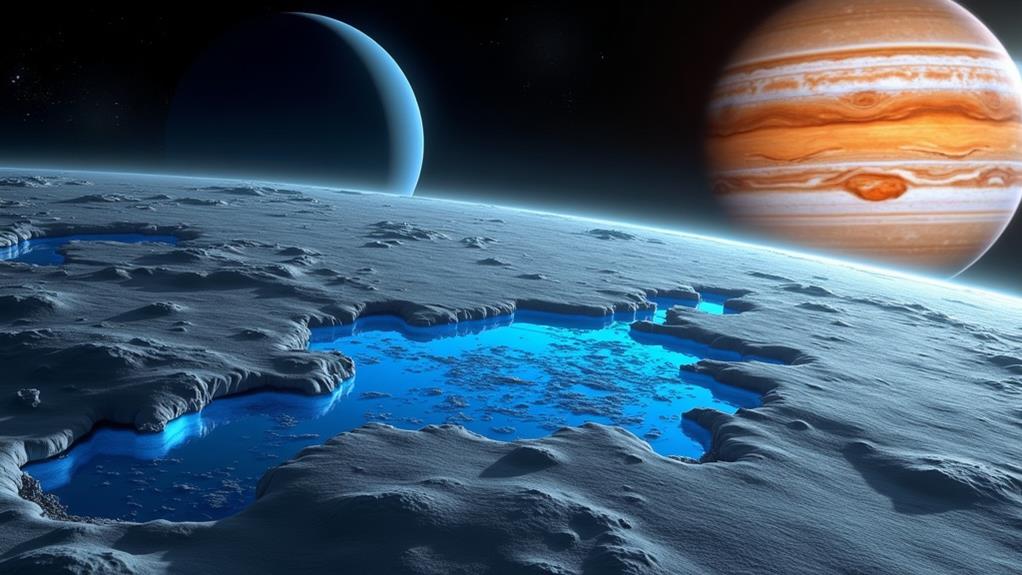
Peel back the icy layers of Europa, and you'll reveal one of the most intriguing mysteries in our solar system—a vast subsurface ocean that could harbor the conditions necessary for life. Europa, one of Jupiter's largest moons, has a diameter of 1,940 miles (3,100 km) and features an ice shell estimated to be between 10 to 30 kilometers (6 to 19 miles) thick. Beneath this shell lies a subsurface ocean that may reach depths of up to 150 kilometers (93 miles), possibly containing twice the amount of water found on Earth.
This ocean is thought to interact with Europa's rocky mantle, creating chemical interactions that could support microbial life. Such unique conditions make Europa a prime target for astrobiological research.
- Subsurface ocean: Contains potentially twice the amount of water found on Earth.
- Ice shell: Estimated thickness of 10 to 30 kilometers (6 to 19 miles).
- Water vapor plumes: Suggest material from the ocean may be escaping into space.
- NASA's Europa Clipper: Mission to investigate the ice shell and subsurface ocean.
- Habitability potential: Chemical interactions with the rocky mantle could support life.
Evidence of water vapor plumes further enhances Europa's habitability credentials. NASA's Europa Clipper mission aims to probe deep into Europa's geology and assess its potential for life, bringing us closer to revealing its secrets.
Volcanic Wonders of Io
Amid the celestial ballet of Jupiter's moons, Io stands out as a volcanic marvel that never rests. As the most geologically active moon in the solar system, Io boasts over 400 active volcanoes constantly reshaping its surface. This volcanic activity is driven by tidal heating, a result of the intense gravitational pull from Jupiter and its fellow Galilean moons, particularly Europa and Ganymede.
Io's diameter measures 2,260 miles (3,640 kilometers), making it a compact powerhouse of geological activity. Its thin atmosphere is primarily composed of sulfur dioxide, and it's frequently punctuated by massive volcanic plumes. These plumes can soar up to 300 miles (480 kilometers) high, showcasing the moon's dynamic nature.
The surface of Io is a vivid tapestry of large lava lakes and extensive plains covered in sulfur and sulfur dioxide frost. These features combine to create a colorful and varied landscape, unlike anything you'll see elsewhere in the solar system. Observations from the Galileo spacecraft have provided incredible insights into these phenomena, highlighting how Io's volcanic wonders make it an unparalleled subject of study. If you're fascinated by active geological processes, Io is truly a spectacle to behold.
Callisto's Ancient Craters
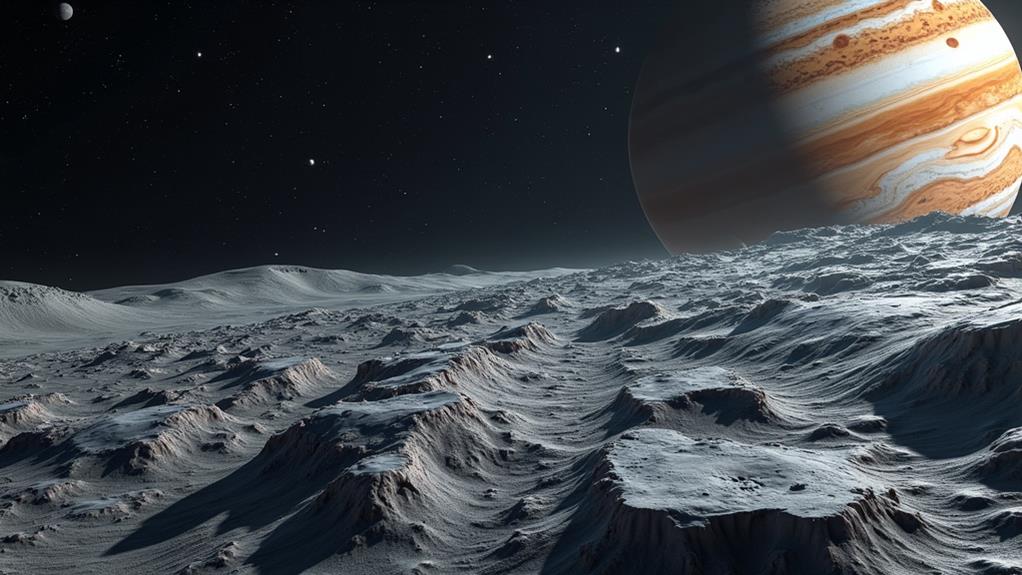
When you look at Callisto, you'll see a moon that's a tribute to the ancient past of our solar system. It's the third-largest moon of Jupiter, spanning 2,995 miles (4,820 km) in diameter, and it's known for its heavily cratered surface. This landscape tells a story of countless impact events, dating back over 4 billion years.
Callisto's ancient craters make it one of the most intriguing celestial bodies for scientists. The most striking feature is the Valhalla crater, an enormous impact site about 4,000 km (2,500 miles) wide, with concentric rings that reveal its complex geological history. Unlike other moons, Callisto's lack of significant geological activity has preserved these ancient craters, providing a window into the early solar system.
- Heavily cratered surface: One of the most ancient terrains in the solar system.
- Impact events: Evidence of numerous collisions over billions of years.
- Valhalla crater: The largest and most prominent impact site.
- Geological history: Insights into the processes shaping celestial bodies.
- Water ice: Surface composition includes both ice and rocky material.
Saturn's Enigmatic Titan
Titan, Saturn's largest moon, is a world of fascinating extremes that captivates scientists and space enthusiasts alike. With a diameter of about 3,199 miles (5,150 kilometers), Titan outshines even Mercury and stands second only to Ganymede in size among the solar system's moons. This icy moon features a dense atmosphere made mostly of nitrogen, mingled with methane and hydrogen, resulting in a surface pressure 1.5 times that of Earth.
One of Titan's most intriguing aspects is its extensive network of liquid hydrocarbon lakes and rivers. Kraken Mare, the largest of these lakes, stretches over 1,000 kilometers (620 miles) across Titan's surface. The perpetually frigid surface temperature, averaging around -290 degrees Fahrenheit (-179 degrees Celsius), allows these liquid methane and ethane bodies to exist, making Titan an unusual and compelling destination for investigation.
The moon's unique environment, with its potential for prebiotic chemistry, makes it a prime candidate for astrobiological studies. To probe deep into Titan's mysteries, missions like Dragonfly are planned, aiming to investigate its surface and atmosphere. You can look forward to groundbreaking revelations from these upcoming missions, shedding light on Titan's enigmatic nature.
Icy Enceladus
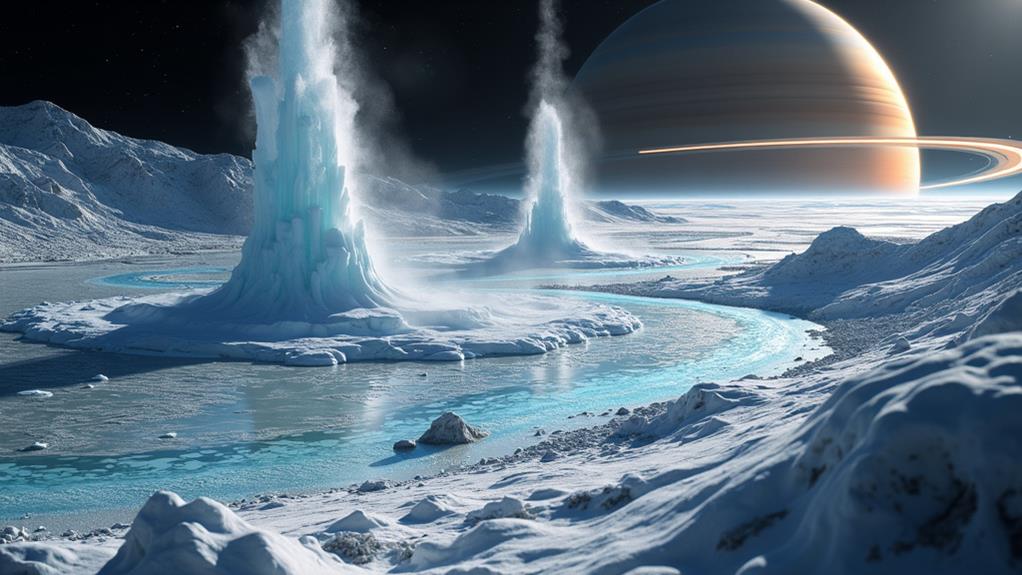
Enceladus, one of Saturn's most enchanting moons, boasts a smooth, icy surface that conceals a fascinating secret beneath. This moon, with a diameter of approximately 313 miles (504 kilometers), has geysers ejecting water vapor and ice particles, indicating the presence of a subsurface ocean. The Cassini spacecraft's observations revealed a global ocean beneath Enceladus' icy crust, possibly in contact with a rocky core, which increases its astrobiological significance.
Consider why Enceladus captivates scientists and space enthusiasts:
- Subsurface Ocean: Liquid water beneath the icy surface amplifies the moon's potential for harboring life.
- Organic Compounds: Detected in the moon's plumes, these compounds are vital building blocks for life.
- Tidal Forces: Heat generated by Saturn's gravitational pull keeps the subsurface ocean in liquid form.
- Extraterrestrial Life: Enceladus is one of the most promising places to search for life beyond Earth.
- Cassini Spacecraft: Provided critical data and high-resolution images, transforming our understanding of Enceladus.
Enceladus' relatively low surface temperature of about -330 degrees Fahrenheit (-201 degrees Celsius) contrasts with the heat generated by tidal forces, maintaining its subsurface ocean. These unique conditions make Enceladus a prime candidate for astrobiological studies and future exploration.
Mysterious Hyperion
Hyperion, one of Saturn's most bewildering moons, grabs your attention with its irregular, sponge-like shape and chaotic rotation. It's the largest irregularly shaped moon in the Solar System, boasting a diameter of about 168 kilometers (104 miles), making it even more significant than Saturn's moon Mimas. What truly sets Hyperion apart is its unique structure, with roughly 40% of its volume being empty space, giving it the appearance of a "rubble pile" asteroid.
When you investigate images captured by the Cassini spacecraft, Hyperion's surface reveals numerous impact craters, including a giant one that bears an uncanny resemblance to the Death Star from Star Wars. These detailed images highlight the moon's bizarre and intriguing features, offering a glimpse into its mysterious nature.
Hyperion's chaotic rotation and unusual orbit are influenced by its gravitational interactions with Saturn and its other moons. This erratic movement makes it a fascinating subject for scientists and space enthusiasts alike. As you compare it to Jupiter's largest moons, Hyperion stands out as a unique and enigmatic celestial body in our Solar System, continuing to intrigue and puzzle researchers who study Saturn's moons.
Future Exploration Missions
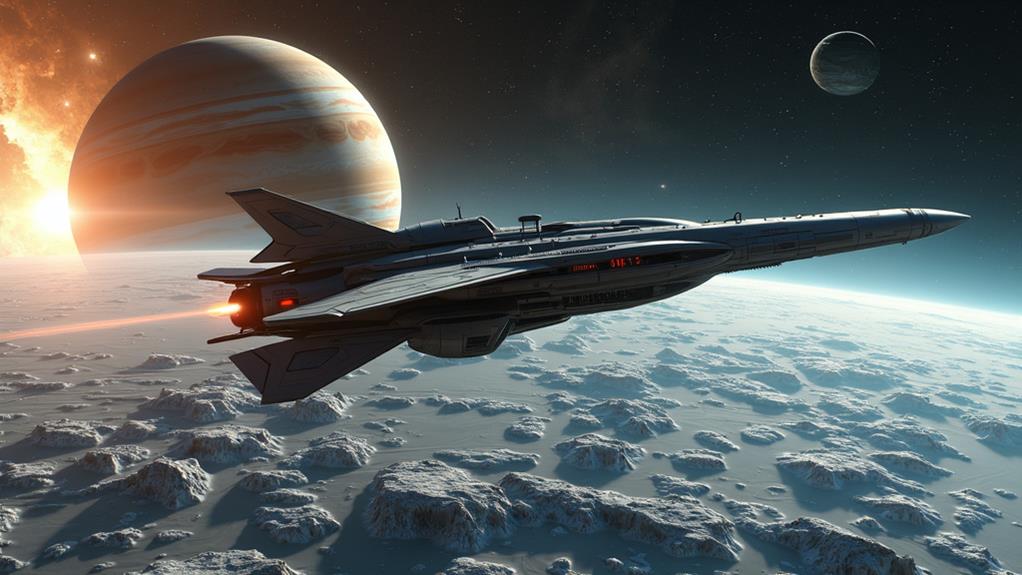
As you marvel at Hyperion's chaotic rotation and irregular shape, it's hard not to wonder about the broader future of moon exploration. Future exploration missions are poised to reveal the secrets of Jupiter's and Saturn's moons, offering tantalizing clues about their potential for life.
Here's what's on the horizon:
- Europa Clipper mission: Launching in the 2020s, this mission aims to study Europa's ice-covered ocean, evaluating its habitability.
- NASA's Juno spacecraft: Since 2016, Juno has been conducting flybys of the Galilean moons, gathering essential data on their compositions and magnetic fields.
- ESA's JUICE mission: Set to investigate Ganymede, Europa, and Callisto, JUICE will examine their icy surfaces and subsurface oceans.
- Geological history: Continued missions will probe into the moons' geological past, helping us understand their formation and evolution.
- Potential for life: Advanced instruments will analyze atmospheres and surface conditions to search for biosignatures.
These future exploration missions will improve our understanding of the Galilean moons, their subsurface oceans, and their geological history. By studying their icy surfaces and potential for life, we'll broaden our knowledge of these distant worlds and the dynamics of the Jovian system.
Frequently Asked Questions
Which Is the Largest Moon of Jupiter and Saturn?
Imagine the vast beauty of Jupiter's atmosphere and Saturn's rings. For Jupiter, the largest moon is Ganymede, a giant in moon exploration with fascinating geology. It's even bigger than Mercury! Saturn's colossal moon, Titan, comes next, famous for its methane lakes. These celestial bodies, along with Callisto's craters, Europa's ice, and Io's volcanoes, offer incredible insights into planetary formation and the universe's mysteries.
Who Discovered the 4 Largest Moons Around Jupiter?
You're asking about the revelation of Jupiter's four largest moons, known as the Galilean Moons. Italian astronomer Galileo Galilei revealed them in 1610 using a telescope, marking a monumental moment in astronomical significance. His findings on these moons fundamentally changed our understanding of orbital dynamics and planetary exploration. Despite some historical context involving Simon Marius, Galileo's observations had a lasting impact on the scientific collaboration and study of moon composition and telescope technology.
Has There Been Any Mission to Ganymede?
Imagine peeling back the layers of an onion; that's what Ganymede exploration has been like. Missions like Galileo, Pioneer 10 and 11, and Voyager 1 have unraveled its atmosphere, magnetic field, and surface features. Juno's 2021 flyby revealed more about its ice composition and geological activity. Future missions like ESA's JUICE aim to dig deeper into its potential habitability. Telescopic observations continue to complement these fascinating findings.
What Are the Top 4 Biggest Moons of Jupiter?
You're curious about Jupiter's biggest moons? The top four are the Galilean satellites: Ganymede, Callisto, Io, and Europa. Ganymede boasts a subsurface ocean, Callisto is covered in craters, Io is famous for its active volcanoes, and Europa's icy crust hides a potential ocean. These moon formations are shaped by tidal heating, and their atmospheric composition is a focus for exploration missions. Each offers unique insights into our solar system.

